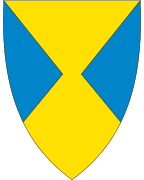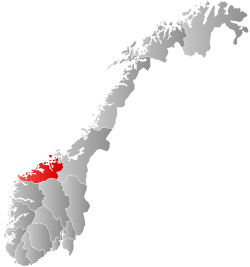Stranda
| Stranda kommune | |||
|---|---|---|---|
| Municipality | |||
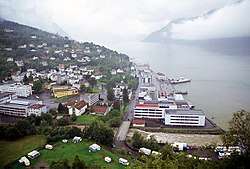 View of the village of Stranda | |||
| |||
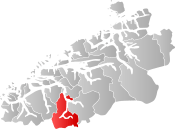 Stranda within Møre og Romsdal | |||
| Coordinates: 62°11′29″N 06°56′56″E / 62.19139°N 6.94889°ECoordinates: 62°11′29″N 06°56′56″E / 62.19139°N 6.94889°E | |||
| Country | Norway | ||
| County | Møre og Romsdal | ||
| District | Sunnmøre | ||
| Administrative centre | Stranda | ||
| Government | |||
| • Mayor (2011) | Jan Ove Tryggestad (Sp) | ||
| Area | |||
| • Total | 865.86 km2 (334.31 sq mi) | ||
| • Land | 844.65 km2 (326.12 sq mi) | ||
| • Water | 21.21 km2 (8.19 sq mi) | ||
| Area rank | #129 in Norway | ||
| Population (2017) | |||
| • Total | 4,623 | ||
| • Rank | #215 in Norway | ||
| • Density | 5.5/km2 (14/sq mi) | ||
| • Change (10 years) | 2.7% | ||
| Demonym(s) |
Strandar Strander[1] | ||
| Time zone | UTC+01:00 (CET) | ||
| • Summer (DST) | UTC+02:00 (CEST) | ||
| ISO 3166 code | NO-1525 | ||
| Official language form | Nynorsk | ||
| Website |
www | ||
Stranda is a municipality in Møre og Romsdal county, Norway. It is part of the Sunnmøre region. The administrative centre of the municipality is the village of Stranda. Stranda consists of three smaller villages and one larger central village. The smaller villages are Hellesylt, Geiranger, and Liabygda. The central village, Stranda (same name as the municipality), has about 2,600 inhabitants. There is also the small village of Helsem which is located just south of the village of Stranda. Stranda Municipality is also known for tourist attractions like the Geirangerfjorden and Sunnylvsfjorden.
The 866-square-kilometre (334 sq mi) municipality is the 129th largest by area out of the 422 municipalities in Norway. Stranda is the 215th most populous municipality in Norway with a population of 4,623. The municipality's population density is 5.5 inhabitants per square kilometre (14/sq mi) and its population has increased by 2.7% over the last decade.[2]
General information
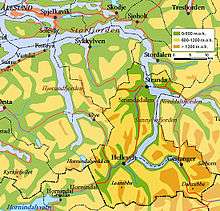
The parish of Stranden was established as a municipality on 1 January 1838 (see formannskapsdistrikt). On 1 January 1892, the northern district of the municipality (population: 850) was separated to form a new Stordal Municipality. This left Stranda with 1,459 residents. The spelling was changed to Stranda in 1918. On 1 January 1965, Sunnylven Municipality (population: 1,221) was merged into Stranda, forming a new, larger Stranda Municipality.[3]
Name
The Old Norse form of the name was Strǫnd. The name is identical with the word strǫnd which means "beach" or "strand". Before 1918, the name was written Stranden.[4]
Coat-of-arms
The coat-of-arms is from modern times. They were granted on 2 May 1986 and were designed by Jarle Skuseth. The arms show a gold and blue figure which symbolizes the fjords and mountains hovering over the beach.[5]
Churches
The Church of Norway has four parishes (sokn) within the municipality of Stranda. It is part of the Austre Sunnmøre deanery in the Diocese of Møre.
| Parish (Sokn) | Church Name | Location of the Church | Year Built |
|---|---|---|---|
| Stranda | Stranda Church | Stranda | 1838 |
| Liabygda | Liabygda Church | Liabygda | 1917 |
| Sunnylven | Sunnylven Church | Hellesylt | 1859 |
| Geiranger | Geiranger Church | Geiranger | 1842 |
Geography

The West Norwegian Fjords, entailing Geirangerfjord and Nærøyfjord was inscribed on UNESCO's World Heritage List in 2005 at the 29th Session of the World Heritage Committee in Durban, South Africa. The West Norwegian Fjords is the first natural World Heritage site in Norway, and the third natural site in the Nordic – Baltic region.
The West Norwegian Fjords are characterised as the best geologically developed and preserved example of classic fjord landscape. The geology and ongoing erosional processes have provided a basis for the active development of ecological and biological processes as well as the development of traditional, in part extreme, land use that has not harmed the integrity of the natural site.
Due to its beauty, the site represents some of the most visited sceneries in the Nordic countries. The area offers exceptional examples of landforms shaped and developed by ice and water, a unique landscape with significant geomorphological features, and a very young landscape in terms of Earth history that is continuously being formed by active erosional processes. The area represents the most extreme, dramatic and magnificent fjord landscape in the world and has an exceptional natural beauty and aesthetic importance.
The Seven Sisters waterfall is located along the Geirangerfjord. The mountain Dalsnibba and the lake Djupvatnet are located along Norwegian County Road 63 in the southern part of the municipality. The mountains of Kvitegga and Hornindalsrokken lie on the southern municipal border.
Government
All municipalities in Norway, including Stranda, are responsible for primary education (through 10th grade), outpatient health services, senior citizen services, unemployment and other social services, zoning, economic development, and municipal roads. The municipality is governed by a municipal council of elected representatives, which in turn elect a mayor.
Municipal council
The municipal council (Kommunestyre) of Stranda is made up of 25 representatives that are elected to four year terms. Currently, the party breakdown is as follows:[6]
| Party Name | Name in Norwegian | Number of representatives | |
|---|---|---|---|
| Labour Party | Arbeiderpartiet | 3 | |
| Progress Party | Framstegspartiet | 5 | |
| Conservative Party | Høgre | 3 | |
| Christian Democratic Party | Kristelig Folkeparti | 2 | |
| Centre Party | Senterpartiet | 11 | |
| Liberal Party | Venstre | 1 | |
| Total number of members: | 25 | ||
Tourism

Tourism has long and strong traditions in Stranda. The villages of Geiranger and Hellesylt have long been well-known destinations. The first cruise ship with tourists from abroad came to Geiranger in 1869. Today, Geiranger is the second largest cruise ship port in Norway, visited by 160 cruise ships every summer. The Coastal Steamer (Hurtigruten) runs daily round trips Ålesund-Geiranger from April to mid-September. Altogether about 700,000 tourists visit Geiranger each summer.
Royal persons, especially Queen Sonja, have contributed to make the fjord famous all over the world. By annual trips, visiting, and even spending the night on these abandoned mountains farms such as Skageflå, and publishing a book about these trips with her own photos that have also been exhibited in New York, among other places. Other historic farms include Knivsflå and Me-Åkernes.
Sports and leisure
In the alpine area at Strandafjellet, there are six Ski tows and alpine pistes. Each winter alpine competitions are hosted there. Strandafjellet is one of the few places in the world where one could actually ski from the top of a mountain and go the whole way down, to the fjord. Every year roughly 250 telemark skiers come together in the race Alperittet, from 1,230 metres (4,040 ft) above sea level and down to the fjord. The Geiranger – From Fjord to Summit race runs from Geiranger to Dalsnibba each year.
Culture
In Hellesylt, one may visit Hægstad Gård which contains woodcarvings, scenes from Peer Gynt by Henrik Ibsen, and in Geiranger the new Norwegian Fjord Centre shows local history and pictures from Geiranger.
Trade and industry
The municipality of Stranda has a great variety as to trade and industry. About 160 farms produce milk and meat products. Many factories have long traditions for making meat products, especially salted and cured meat. Also the making of furniture and textile products is an important industry that gives good work to many persons. Stranda is the place where P.I. Langlo industrialized the furniture industry in Norway in 1929. (There is almost no unemployment in the area). The Grandiosa factory, Norway's biggest pizza-producing factory is situated in Stranda. There are also much aquafarming and many fish processing factories in the municipality. Tourism is, of course, a very important business in the whole district.
In popular culture
- Released in March 2016, "The Wave (Bølgen)" is a Norwegian disaster movie based on the premise of a rock slide from the mountain Åkerneset inundating the town of Geiranger.[7]
Notable residents
- Arve Henriksen (born 1968), musician
- Are Kalvø (born 1969), writer and comedian
- Kristian Langlo (1894–1976), Norwegian politician
- P.I. Langlo (1892–1940), pioneered the industrial manufacturing of furniture in Norway
- Olav Berntsen Oksvik (1887–1958), social democratic politician
- Margreth Olin, film director
- Peter Opsvik (born 1939), famous furniture designer and Jazz saxophonist
- Bjarne Solbakken, alpine skier
- Pål Øie, film director
- Sophie Sjåstad Vågsæter, known for an affair with Manchester United football player Antonio Valencia
See also
- Norwegian Colony, a Norwegian community in California established by families from Stranda.
References
- ↑ "Navn på steder og personer: Innbyggjarnamn" (in Norwegian). Språkrådet. Retrieved 2015-12-01.
- ↑ Statistisk sentralbyrå (2017). "Table: 06913: Population 1 January and population changes during the calendar year (M)" (in Norwegian). Retrieved 2017-10-19.
- ↑ Jukvam, Dag (1999). "Historisk oversikt over endringer i kommune- og fylkesinndelingen" (PDF) (in Norwegian). Statistisk sentralbyrå.
- ↑ Rygh, Oluf (1908). Norske gaardnavne: Romsdals amt (in Norwegian) (13 ed.). Kristiania, Norge: W. C. Fabritius & sønners bogtrikkeri. p. 126.
- ↑ "Kommunevåpen" (in Norwegian). Stranda kommune. Archived from the original on 24 July 2011. Retrieved 25 October 2008.
- ↑ "Table: 04813: Members of the local councils, by party/electoral list at the Municipal Council election (M)" (in Norwegian). Statistics Norway. 2015.
- ↑ "The Wave (2015) Bølgen (original title)". IMDb. Retrieved 16 March 2016.
| Wikimedia Commons has media related to Stranda. |
External links
- Municipal fact sheet from Statistics Norway (in Norwegian)
- West Norwegian Fjords UNESCO World Heritage Site (in Norwegian)
- Storfjordens Venner (in Norwegian)
- Strandafjellet downhill skiing
- Visit Geiranger
- Norwegian Fjord Centre
- Destinasjon Geirangerfjord – Trollstigen
- Local information and news (in Norwegian)
- Sunnmøringen local newspaper (in Norwegian)
- Map
